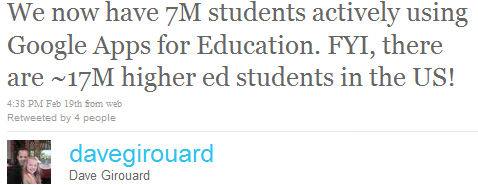Google vs. Microsoft: Number wars, students as weapons

Microsoft and Google are still plotting away at each other in attempts to get colleges and universities on side with their own email, document and general productivity suites.
Google hasn't got back to me with any of the questions I sent over in regards to this vague tweet:
Since then there has been an awful lot of email to'ing and fro'ing between myself and a number of public relations folk. My last post comparing the two suites was a few months ago; it's time for a revision and seeing where universities rank the in-house email killers, by deconstructing the jargon and seemingly meaningless spin.
Google Apps is used by only 7 million students
This surprised me, actually. The aforementioned tweet suggests that around 40% of US students were using Google Apps for Education, when in fact no, only 7 million users worldwideare using the suite. While enterprise and business customers may well be using Google Apps for their own, educational institutions are simply not picking it up as much as Live@edu.There only seem to be a few dozen establishments using the service, according to their mashup. Google have yet to release further detailed statistics, but considering there are over 300 educational institutions in the UK alone, this doesn't seem to bode well for Google's statistics.
Live@edu is used by more than 10,000 "schools"
Microsoft finally updated its press release to confirm that over 10,000 "schools" - which as Americans often describe school as "a form of education" not mutually exclusive to compulsory education but university/college also. Considering most universities have over 10,000 students, I would fairly say that there are definitely over 7 million users using Live@edu; it's probably closer to 50 million if not even more.However, deeply embedded in a statement about how the public sector identifies federation services (yawn), it states near the very bottom:
"Florida State College at Jacksonville and the University of South Carolina are recent wins and join the thousands of other institutions in more than 100 countries already providing Live@edu to tens of millions of students worldwide."
Well that settles that then. They're ahead of Google with "tens of millions of students" using the product.
Why is Live@edu so far ahead?
I believe it's down to three main reasons.- It's built on Exchange Server 2010 and was rolled out to students way before it was released, using students as unbeknown testers. Universities already use Exchange most of the time for at least their staff to communicate and collaborate, so by branding alone, "Exchange" sounds good to them.
- Active Directory integration is far easier. Google Apps requires the use of the API to synchronise LDAP or Active Directory (the most common) accounts so users can have their university email address or username and password to sign on to the service, without the need for another set of credentials. Live@edu does make it easier, but that is again due to the fact that more often than not, they're using existing Microsoft technology.
- Most universities are already "Microsoft campuses" in the fact that they already have licensing and "long standing agreements" in place to keep their services, email, products and systems running and ticking over. All it takes is one small plug from a representative who the university already trusts, and bang - you end up using more Microsoft technology.
For now, although there is no definitive proof as actual product statistics are scarce and both Microsoft and Google are holding back actual figures - no doubt to try and psyche out the opponent - it seems Microsoft's Live@edu software is racing far ahead of Google Apps for Education.
